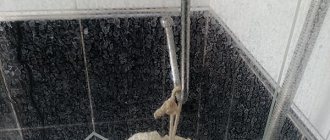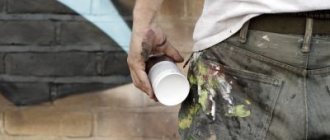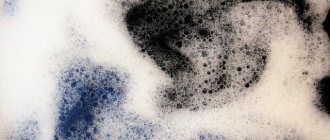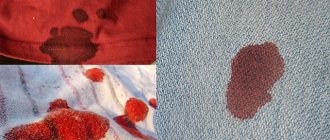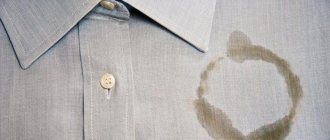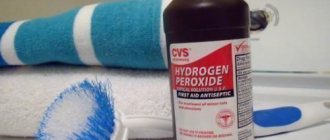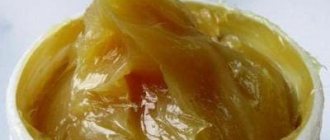Operation Anti-grease, or how to remove a greasy stain on clothes
Grease stains on clothes can be divided into 2 categories: fresh and old. It is difficult to get rid of them effectively.
And if fresh ones can be removed using improvised means, then special cleaning products will be required to combat old stains.
And in some cases, it is completely impossible to get rid of them at home, and you have to go to dry cleaning.
We will tell you in the article whether and how to remove a greasy stain on clothes (fresh or old) at home.
How to remove fish oil smell from clothes
Every housewife is familiar with the problem of greasy stains on trousers, shirts or dresses.
They are almost impossible to scrub off and remove during hand or machine washing, so you have to use various methods to get rid of the problem at home. How to remove a greasy stain from suede, linen or cotton fabric? How to wash fat from trousers, shirts or dresses correctly and quickly? What products are needed for white or colored fabric? Folk remedies will come to the rescue.
Preparatory stage
Before cleaning, you need to remember a few simple rules and prepare the necessary materials for this:
- First of all, carefully study the label from the manufacturer. There you can find recommendations for the choice of detergents, washing mode and water temperature.
Do not neglect this rule, as this significantly increases the chances of not ruining your clothes when washing.
- Prepare the necessary materials: cotton cloth or paper, a soft brush, a cotton pad or a piece of clean cloth, clean water and materials for the solution.
- Using a soft brush, you need to clean your clothes from foreign objects: dust, wool, dirt, etc.
- When diluting the solution, use the weakest concentration; if there is no effect, then gradually increase it.
- Be sure to turn the item inside out. Place a cotton towel or paper under the stain, first folding it in several layers, and only then begin cleaning.
Before you start cleaning, you need to test the solution on an inconspicuous area of the item or a test piece of fabric, if you have one. This procedure will significantly increase the chances of not ruining the item.
How can you grow something you just planted at home?
If the stain is still fresh, it will be much easier to get rid of than an old one. This can be done at home, using both improvised means and chemicals.
- Salt: Regular table salt will do. You need to sprinkle it on the stain and use a sponge to gently rub it into the fabric. Then leave it for a while so that it absorbs all the fat.
Next, use a soft brush to shake off the residue; if it was not possible to remove the stain the first time, repeat the procedure. Chalk. This method is similar to the previous one, the only difference will be the algorithm of use.
You don’t need to rub chalk into your clothes like salt; just sprinkle the stains on top and wait one hour. Use a damp cloth to remove any traces of chalk.
It is better to choose trusted manufacturers and not use a cheap product. A good choice would be "Fairy". It copes equally well with all types of contaminants, the important condition is that they are fresh. This method does not require preliminary preparations, just apply a little product to the contaminated area and, using a cotton pad, rub it well into the fabric until foam forms. Leave for 15 minutes and wash in warm water.
Tips for getting rid of fresh stains
The faster you act on fat, the easier it is to remove it from the tissue.
How an iron can help
Its benefits in the fight against oily stains are relative. Heat not only helps the grease to be absorbed onto the underlying cloth or layer of starch, but also makes it easier for dirt to penetrate deep into the fibers of the item itself. And if you choose the wrong temperature, the fat will only stick to the outfit. Therefore, when getting rid of contaminants, it is better to use less risky methods.
Ammonia
A solution containing ammonia does a good job of removing greasy stains of various ages. Prepare a mixture of 2 parts boiled water and one part ammonia. This substance does not smell very pleasant, so it is only suitable for home use.
The stain is treated in several stages, each time washing the area of the item and blotting it from excess moisture before applying the next portion of the mixture. Wool, cotton, silk or fabrics with unstable colors may not withstand the effects of such a degreaser.
Shampoo for oily hair
The product will cope well with the most recent stains, but it is ineffective against old marks. Still, the task of shampoo is to partially remove fat and dust from the hair, and not to degrease the scalp and hair, as they say, until it squeaks.
Do you wash by hand?
Oh yes! No
Powder absorbents
Outside the home, when there are no special anti-stain products at hand, you can always use:
- Lime powder (you will have to find a wall painted with lime and use your fingernail to get a couple of pinches of white dust).
- Talcum powder (mothers walking with their children will help out).
- Loose powder.
- Starch (if you are visiting a friend and the stain is not on a fur item - the latter are difficult to clean from the remnants of potato flour).
The processing principle is the same as when using salt and soda.
Laundry soap
It has an excellent effect on fresh stains, but its chemical properties are not enough to combat old traces of fat. Mixing with turpentine and ammonia is not very rational, because the resulting mixture is quite caustic and can damage delicate fabrics and leave stains on dense ones.
Chalk
It perfectly absorbs fat from fabrics, so you can carry a couple of pinches with you in a plastic bottle so that you are always ready to defend the attractive appearance of your item. You should not use chalk on fur, especially dark fur - during the wet cleaning process it can stick together in small lumps, which will greatly spoil the overall appearance of the product.
Laundry soap
How to remove old stains at home?
It is much more difficult to remove old marks, but this is possible both with the help of improvised means and chemicals.
- Brine. Add a glass of salt to a bowl of water and stir well. Soak clothes in this solution for 3 hours, then wash as usual.
- Vinegar. It will help you get rid of the juice of berries and grass. Soak a cotton pad in vinegar, then apply it to the stain and rinse in cold water.
After rinsing, you need to sprinkle the stain with salt, it will absorb the residue and prevent the stain from spreading.
What to do with old greasy stains
How to remove a greasy stain and clean the fabric of trousers or a T-shirt after a lot of time has passed? Traces can be considered old if 3-4 hours have passed since their appearance. It is not easy to clean fabric from such contamination, but it is quite possible. To get rid of stains, there are the following methods:
- Dissolve ½ cup of salt in a container of hot water and place clothing in the solution. After half an hour, wash the item with laundry soap and rinse thoroughly. This method can only be used on things that cannot fade.
- Wipe the stain with a swab dipped in gasoline or turpentine, after placing a thick napkin or sheet of paper under the fabric. It is recommended to clean greasy stains from the edges to the inside, periodically replacing dirty swabs with clean ones. Afterwards, wash the item in warm water.
- Combine turpentine and ammonia in 1:1 proportions. Apply the resulting liquid to the problem area for 4-5 hours. Afterwards, you need to wash your clothes in a warm soap solution.
- Apply a small amount of glycerin to the fabric, and after 30-40 minutes, remove any remaining dirt using a cotton swab. This method is also suitable for fresh greasy stains.
- Dilute baking soda with warm water to form a paste. Apply the solution to the grease stains, and when it dries, remove the remaining soda and wash the item.
- Pour 0.5 liters of Coca-Cola or Sprite into a bowl of warm water and soak the soiled item in the container. After a few hours, wash your clothes as usual.
- Mix equal amounts of vinegar (not essence!) and warm water and soak clothes in the solution for 10-15 minutes. Then wash in warm soapy water and rinse thoroughly. This method is suitable for getting rid of greasy stains on fabrics that may fade.
Removal from different types of tissues
Some products work better on certain types of fabrics. Next, let's look at what products are best used for products made from:
- Cotton. Ordinary gasoline works well to get rid of greasy marks on cotton clothes. The product is very aggressive, so it must be used in small proportions.
It is best to slightly moisten the contaminated area of the cloth, place a paper napkin under the stain and wait until the gasoline is absorbed.
In order not to spoil the item, first test the effect of the selected product on an inconspicuous area of the fabric.
Boiling
If the smell of fish cannot be removed by regular washing, you can use boiling. This method is suitable for white natural fabrics that are resistant to high temperatures.
For boiling, you will need a large enamel container and tongs for hot laundry. A basin or pan is filled with water and placed on fire. Add crushed laundry soap.
When the water boils, the smelly clothes are completely dipped into the container. Keep the basin with laundry on the fire for 30-40 minutes. Then it is taken out and put into the washing machine.
We suggest you familiarize yourself with How to cover storage boxes
Boiling even gets rid of the smell of rotten fish.
What is the difference between washing white and colored fabrics?
Washing white and black items is significantly different from washing colored items. Many folk remedies are ideal for white and black things.
For example, to remove dirt on a white fabric, you can use:
The steaming method using tracing paper is also used.
Dirt on black clothing can be soaked in CocaCola or Pepsi and then thrown into the washing machine. They also use mustard powder, diluting it with water to form a porridge and rubbing it into the greasy stain.
It has a high price tag, but the line includes many products for different types of fabrics. Using this product will allow you to safely remove greasy stains without losing the color quality of the item.
Folk remedies include a solution of water, salt and ammonia. Dilute the solution in proportions 1:1:1. This will help effectively remove oil and grease stains without damaging the fabric.
How to choose the best method depending on the type of fabric
The easiest way to get rid of the smell of fish on clothes is if they are made of white cotton or linen. These materials can be cleaned using chlorine bleach. Chlorine effectively eliminates any unpleasant odors, including fishy ones. An item washed with bleach must be rinsed several times and dried in fresh air.
Clothes treated with chlorine will have a specific odor for some time, which will go away after several washes.
For colored and thin white fabrics, it is better to use oxygen bleaches. They fight odor by gently acting on the fibers without destroying the dye.
Items made of wool and silk are difficult to remove from the smell of fish. Delicate fabrics must not be treated with aggressive substances. Under the influence of various bleaching agents, such material becomes deformed and loses its attractiveness.
Use a saline solution to clean delicate fabrics. It is able to remove the smell of fish from clothes without damaging the fibers of the fabric. To prepare the composition, you need to take warm water and dissolve table salt in it at the rate of 1 tbsp. spoon for 200 ml.
What to do if the item has already been washed?
Once a stain has been placed on clothing, it is highly not recommended to immediately throw it into the washing machine.
In most cases, this will not help get rid of the stain, but will only worsen the situation; not only will it not be washed off, but it will also spread over a larger area of the product.
If it happens that the item was washed, it’s okay, it can be fixed. First of all, you can use one of the presented methods for removing old stains.
Before doing this, you need to pay attention to the type of fabric and choose the appropriate method so as not to aggravate the situation even more.
If the item is expensive, it is better not to risk it at all, but to go to dry cleaning. It is equipped with professional equipment to remove all types of stains. It will cost a little more than cleaning at home, but the result is guaranteed to be positive.
You will find maximum useful information about washing clothes and various fabric products here.
How to remove old grease stains at home
Grease stains on clothes bring discomfort, as they are very noticeable and greatly spoil the appearance. The most difficult stains to remove are those that appeared a long time ago and have had time to be well absorbed into the fabric. To remove them, it is necessary to use more effective means that can dissolve even such contaminants.
How to remove oil from clothes: wash away traces of canned food and deal with sea buckthorn redness
Stains on clothes can ruin even the most rosy mood, especially if they are traces of oil. But you can also get rid of serious contaminants. There are quick and effective methods for removing oil stains from clothes without dry cleaning. For this purpose, both “soft” cleaners and more aggressive ones are used. Of all the options, it is necessary to choose those that will not spoil the fibers of the fabric and will not “eat” its color.
To properly remove oil stains from clothes, it is important to find out the origin of these unsightly marks. Oils are divided into two large categories: household use and technical. Household products include olive, sunflower, corn, soybean, and butter. You can also add cosmetics here. And for production ones - mineral, transmission, diesel. When these substances get on clothes, they leave “blots” without an even outline, quickly becoming covered with a dusty layer. Where can you get dirty? Yes, everywhere:
- during cooking (for example, splashes from the soup scattered);
- at a festive feast;
- during street snacks (from shawarma or pies);
- in public transport;
- on rides or swings;
- while repairing the car.
Basic rules for breeding and preparation of material
Stains can be removed using modern means or traditional methods. There are a number of rules, following which you can easily remove any greasy mark on clothes:
- To ensure that after removing the oily stain there are no traces left on the material, it is necessary to place several layers of thin material under the fabric (it is better if it is cotton knitwear).
- If the fabric is thick and the dirt has penetrated deeply into the structure of the material, you should use a medium-hard brush, well soaked in a solvent, instead of cotton fabric.
Popular household chemicals for quickly removing old grease stains from various fabrics
In order for the result to be good, it is necessary to find out the composition of the fabric and select the appropriate detergent.
Knitwear
Oily stains can ruin the appearance of any knitwear product. Therefore, before removing a grease stain on knitted fabric at home, you need to test each method on a small area of the fabric. To remove greasy stains use:
- Special cleaning agent for dishes. The grease-dissolving composition is applied to the stain for a quarter of an hour, after which the item is washed and rinsed thoroughly in warm water.
- Laundry soap 72%. Contaminated areas are generously soaped and left for several hours. If the mark is fresh, it will be enough to wash the clothes in a soapy solution.
- Petrol. Before removing a grease stain from clothing, you must read the tag. The dirt should be soaked in gasoline using a cotton swab. For the fat to disappear without a trace, it is enough to keep the liquid on the canvas for just a few minutes. Then the item should be washed by hand or in a washing machine. To remove the smell of gasoline, clothes must be dried in the open air.
- Acetone or nail polish remover. If the stain is small, just drop a few drops onto the problem area and rub the liquid over the greasy mark. After 30 minutes the material can be washed.
- Salt. If it is not possible to use a detergent, but the oily trace needs to be removed urgently, cover it with salt. The procedure can be carried out several times. When finished, wipe the area with bread crumbs.
- Laundry soap and sugar. The procedure looks like this: the oily stain is moistened with hot water, then the problem area is soaped with laundry soap, sprinkled with sugar and rubbed in lightly. After 15 minutes, the knitwear can be washed.
- Shaving foam. It also copes well with oil marks. Just rub it into the problem area and keep it on the fabric for about 15 minutes. After the knitwear is well saturated with the composition, it must be washed.
- Medical alcohol. In order for it to remove the oily stain, you need to apply the liquid with a cotton swab to the knitwear and keep the composition on the fabric for at least an hour.
White cotton
You can remove fat from cotton fabric with dishwashing detergent, laundry soap with sugar, salt, and soda. You can also achieve good results:
- Crushed chalk. Apply chalk powder to a fresh mark and leave it overnight. Then you will need to wash the area with laundry soap.
- Alcohol. The contaminated area is moistened with ethyl composition and locally washed. If necessary, the procedure is carried out several times.
- Potato starch. Powder of organic origin is poured onto the greasy area and lightly rubbed into the problem area. After 15 minutes, the procedure is repeated with a new portion of starch until the contamination disappears.
- Ammonia. The chemical solution is poured onto the oily mark for 10 minutes, then washed off with laundry soap.
- Acetic acid 9%. The contaminated area of fabric is soaked in the solution for 5 minutes, then the cotton is washed and rinsed.
- Hydrogen peroxide. This liquid product can simply be poured onto an oily mark. After 10–15 minutes, the item can be put into the washing machine.
- Tooth powder, baking soda or baby powder. Any available powder is poured in a thin layer (3 mm) onto the greasy stain. A new napkin is placed on top and ironed. Then oppression is placed on it and held for at least 7 hours. Several treatments may be required to completely eliminate fat.
Colored fabric
Removing stains on colored clothes requires special delicacy, as the problem area can be discolored. In this case, it is possible to remove greasy stains:
- Potato starch. A thick paste is applied to the stain for a 10-minute period. Moistened paper napkins are placed under the fabric.
- Shampoo for oily hair. It helps if you pour it onto a colored canvas and leave it on the problem area for 60 minutes. Then the item must be washed.
- Vinegar with mustard powder and salt. The components are mixed in equal proportions, dissolved in a small amount of water and applied to the greasy stain. The composition remains on the fabric for 20 minutes, after which the item is washed.
- Drink Sprite (or Coca-Cola). This product should be used to remove stains on dark colored clothing. Simply pour the drink onto the oily mark and hold it on the problem area for 2-3 hours. After this, the item needs to be washed.
- Tooth powder. It is poured onto the dirty area and rubbed in lightly. Once saturated with fat, the powder is removed and another is applied. The cleaning process is performed several times until the oily trace is removed.
- Bread crumb. The product is soaked in water, then spread over the dirty area for a 20-minute period. At the end of this time, the clothes are washed.
- Laundry soap. The alkaline environment of the soap solution will not harm colored fabric, so soapy fabric can be safely soaked for several hours.
Important! Before removing grease stains from colored clothing, you should make sure that it has a high-quality paint job. To do this you will have to test it. It will be necessary to apply a stain-removing composition in a remote place and see if it leaves light stains on the fabric.
Black fabric
You can clean black fabric from greasy stains using the following methods:
- Laundry soap. It is necessary to soap the dirty area and leave for several hours. The result will be positive if the oily trace has not had time to age.
- Sugar. You can speed up the cleaning process if you sprinkle it on the soapy area and wipe it. The sugar stays on the fabric for no longer than 15 minutes, then the clothes are washed.
- Salt. It absorbs oil well. Salt is sprinkled generously and rubbed into the greasy stain. It will take several times to wipe off stains with salt. Do not rub chemicals in with force. This factor can lead to the problem area spreading to the sides.
- Blotting paper, which is placed on both sides of the fabric in the area of contamination and ironed with a warm iron. The procedure is carried out until the oil is completely absorbed into the special blotting paper. When a slightly noticeable mark remains, the clothes can be washed in a machine.
- Mustard powder, which is mixed with water until creamy thick and rubbed over the dirty area. After 30 minutes, the clothes can be washed.
- Glycerin. The drug, purchased at the pharmacy, is applied to the contaminated area for 30 minutes. Then the solution is wiped with a cotton swab, and the item is washed as usual.
...and by fabric type
When choosing a method for removing oil stains, you need to take into account the type of fabric. After all, what suits denim can completely ruin guipure.
- Delicate products. A jacket, dress, trousers made of silk or wool can be cleaned well even with laundry soap. You can also remove the oil with ammonia. Warm talc also absorbs such stains on sensitive materials - leave the product on for a day, and then clean it with a brush. And if the product is not machine washable, use potato starch. Rub the powder into the stained area and leave for 15 minutes.
- Things made of cotton. Alcohol is used to remove oil stains from cotton or linen fabrics. Use a cotton swab dipped in the substance to wipe the stain from the edges to the center.
- Fur . Here they also use the talc cleansing method, only a little differently than in the case of silk. You need to pour the powder onto the stain, and put transparent paper on top, which you then heat with an iron.
- Outerwear . You can treat a down jacket made of padding polyester or a jacket made of raincoat fabric with ammonia. The solution is prepared from a glass of warm water and a teaspoon of ammonia. The stain should be wiped with cotton wool soaked in the composition.
- Synthetics. If the T-shirt or sweatpants are made of synthetic fabrics, then a regular store-bought stain remover will usually remove the oil. After treating dirty areas, washing is required.
- Dense materials. For thick knitwear and jeans, you can use any of the following methods. A mixture of vinegar, ammonia and talc (1:1:1) is used to clean upholstery fabrics.
Traditional methods of removing stains
For those who don’t know how to remove grease stains using improvised means, experts have developed a list of options. Stains are easily removed with salt, laundry soap and vinegar.
Laundry soap
If an oily mark has just appeared, you should immediately wash the problem area with laundry soap. If once was not enough, then the procedure will have to be a little more complicated. The dirty area should be heavily soaped, wrapped in a plastic bag and left there overnight. Clothes should be washed in the morning. To enhance the effect of soap, experienced housewives advise grinding it on a grater, dissolving it in warm water, and only then soaking the dirty item overnight. You can speed up the process with dry sugar, which is found in every home. The soaped area should be sprinkled with it and rubbed. After 20 minutes, the clothes can be washed.
There is a simple recipe for how to quickly remove an old greasy stain with a hot saline solution. It is simple, as it requires 150 g of salt poured into 1 liter of water. The stained area will need to be kept in the solution until the dirty mark disappears without a trace.
A mixture of salt and soda in a 1:1 ratio breaks down fat well. The composition is applied to a dirty area moistened with water for 30–60 minutes, then the material is thoroughly washed with laundry soap.
Turpentine
Turpentine combined with ammonia in equal parts effectively removes greasy stains. The solution is applied with a swab to the dirty area and kept on the cloth for up to 3 hours. Then normal washing is recommended.
Ammonia
To remove greasy marks, you can use ammonia. To do this, take 1 tsp. ammonia, which is mixed with 100 ml of water. The dirty item is soaked in the solution for 6 hours, after which you can rinse and wash it in the usual way. This technique should be used in the fight against oily areas only on light-colored fabrics. Dark fabrics may leave a bleached stain.
Vinegar
In practice, housewives have noticed that vinegar exhibits the properties of an effective stain remover. It is often used to remove grease stains on white cotton fabric in its pure form. A greasy stain is removed in a solution of nine percent vinegar. To wash delicate fabrics, prepare a mixture of water, vinegar, salt and mustard, which are mixed in equal proportions.
Attention! To remove stains, do not use vinegar in excess of a 9% concentration.
Starch
Starch can be used to remove grease from fabrics that cannot be washed by hand or in a washing machine. The course of action is as follows:
- The freshly contaminated area is covered with dry starch.
- The powder is lightly rubbed into the fabric and kept in it for at least 20 minutes.
- The procedure is repeated several times until the contamination disappears from the material without a trace.
For your information! For old stains you will need to use hot starch. The powder is also applied to the old stain, covered tightly with a white cloth on top and slightly heated with an iron. Since the fat will be absorbed into the powder slowly, the procedure will have to be repeated several times.
Folk remedies
Often, to get rid of the unpleasant smell of fish, it is enough to use one of the home recipes:
- To permanently remove fish smell from clothes, you can use baking soda. It even removes old fishy smells. Instead of detergent, load a glass of soda into the powder receptacle and wash as usual.
- Add 2 tablespoons of vinegar to a basin with 3-4 liters of warm water. Immerse things and leave for 2 hours. Then rinse thoroughly and wash.
- Dilute 2 tablespoons of vinegar in 2 liters of water. In the resulting solution, wash things with laundry soap. After several rinses, hang it out to dry in the fresh air.
- Things are placed in cold water with salt diluted in it for several hours, then sent to the wash.
In winter, when dried in the cold, unpleasant odors quickly disappear. In summer, you should not dry things in the sun. Ultraviolet light fixes odors in fabrics.
How to remove fish stains
Fish is a very healthy product that helps us look beautiful and young. But it is also food, which leaves behind troubles in the form of stains not only on clothes, but also on furniture, carpet and other surfaces. It is very easy to plant a fish stain; it can simply be carelessness, an animal’s play, or a child’s prank. However, removing fish stains is not as difficult as it might seem; even an inexperienced housewife can handle it.
How to wash fish oil
Many childhood memories are associated with the not-so-tasty “delicacy” that their parents forced them to drink—fish oil. Parents, concerned about the health of their children, voluntarily forced them to drink this thick liquid. The idea was good - to strengthen the immune system and create conditions for the young body to develop correctly. Our mothers and grandmothers were right about this. Also, the use of a natural product helps to normalize metabolic processes, reduce the layer of subcutaneous fatty tissue, remove cholesterol from the blood, and remove harmful substances. Having all these advantages, the liquid is quite difficult to wash off from clothes. Today we will talk about how to remove fish oil, and we will touch on the topic of other “fishy” stains.
Removing stains from clothes
To remove fish stains from clothes, carpet and furniture:
- acetic acid;
- the classic stain remover that you usually use;
- laundry detergent;
- dishwashing liquid;
- glycerol;
- ammonia;
- starch;
- bleach containing a chlorine component;
- dishwashing liquid.
Helpful advice! Since professionals often recommend using turpentine, you must remember that it, in turn, leaves stains. To eliminate them, you need to wash the product with an ordinary soap solution.
You shouldn’t put off removing fish stains for too long; you need to take action immediately after identifying the problem. It will be much more difficult to remove the old stain.
Ways to remove fish stains:
- It is recommended to generously sprinkle starch onto the problem area. This measure will remove excess fat from the product. The product should remain in this position for at least half an hour, then the starch should be removed. Using any brush will help you cope with the task. After this action you need to take 30 ml. vinegar and add it to the water. There should be twice as much water. Use the resulting solution to thoroughly treat fish stains. After this, the product must be washed in a convenient way. To remove odors, it is recommended to use fabric softener.
- If you don’t have the time or desire to spend a long time removing fish stains, then you should use new generation stain removers. They will perfectly remove not only stains, but also unpleasant persistent odors. When using this method, it is worth considering the type of fabric of the canvas.
- If the stains are not fresh, but old, then it will be more difficult to get rid of them, however, it is possible. You will need to use glycerin and ammonia. You need to mix the components in equal proportions, add a little water to the solution. Using a napkin, moisten the stains with the prepared composition and leave in this position for at least a quarter of an hour. This method is applicable to products made from any fabric. Afterwards, you need to rinse the product, then wash it as usual.
- To remove fish stains that have decorated a white cotton product, you need to prepare a basin with warm water and pour 30 ml into the water. bleach, immerse the product in the solution for half an hour, then wash as usual.
- A budget-friendly but very effective way to remove fish stains is to use dishwashing gel. Dish liquid should be poured onto the stains, after a day, rinse the product thoroughly, and then wash it in a convenient way.
Effective ways to remove fish odor from clothes
Fish, thanks to its taste and nutritional properties, takes its rightful place on the everyday, holiday or dietary table. The product has a drawback - a difficult odor that can penetrate and eat into any surfaces or textiles.
Professional dry cleaning will easily remove rotten fishy smells from textiles, carpets, car covers, and clothes. The method is not cheap, it takes time, and not everyone has the opportunity to wait several days for an item. The method is easy, gives 100% results without much effort, and is ideal for some. Others can, using available food products and household products, remove the unpleasant smell of fish and its grease stains on their own. Of the minuses: the process will take several hours (less than dry cleaning), but it requires some effort on the part of the housewife - manual soaking, rinsing.
In emergency situations, dishwashing liquid, citric acid, laundry soap, ascorbic acid, lemon, bleach, washing powder, stain remover pencil, ammonia, hydrogen peroxide, table vinegar will help.
How to remove fish stains from a down jacket or jacket
Jackets and down jackets may also develop fish stains that need to be removed. You can use the following products: paper towel, turpentine, stain remover, iron and washing powder.
- To remove a fresh stain, just take a sheet of paper or a napkin, heat the iron, place the sheet on the stains, and iron it. All the fat will remain on the paper.
- You can use modern stain removers. Such products must be used strictly according to the instructions indicated on the packaging.
- If a feather is used as a filler for outerwear, then you can remove stains with turpentine, but you need to act as carefully as possible so that the solution does not penetrate into the filler. You need to dip a cotton pad in turpentine and treat the problem area. Repeat the procedure as necessary.
How to remove fish stains from furniture and floors
- Let's use alcohol. Paper napkins should be thoroughly moistened with alcohol or any colorless alcohol-containing liquid. For example, vodka. Pure alcohol removes stains more effectively, but it is not so easy to buy. Place napkins on the stains. After 3-5 minutes, rub. At the end of the procedure, you will need to treat the problem area with water and dry it naturally.
- Clean stains with dish gel. You need to take dishwashing detergent and mix it with a small amount of water until a thick foam forms. The foam must be placed on the problem area, and the stains must be thoroughly rubbed with a sponge. Rinse off the foam with water and dry the product.
- To remove old fish stains, you need to treat them with hot water, then drip dish soap onto the stains, leave for 15 minutes, rub, and rinse. Then you need to rinse the problem area with a solution of water and vinegar.
- To ensure that only memories remain of fish stains on the floor, you need to wash the floor with a solution of water and dish gel.
Don't let fish stains bother you anymore!
Source of the article: https://krasna-devica.ru/article/7186-kak-vyvesti-pyatna-ot-ryby
